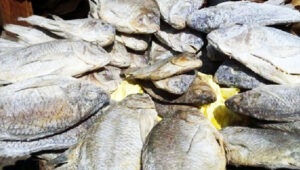Tilapia is a globally produced fish because of its fast growth, tolerance, and adaptability. Tilapia comes in a variety of colours and sizes with a fully matured tilapia growing up to 20 inches and weighing 5-6 pounds in a suitable environment.
The word koobi is the local name for processed tilapia with an extended shelf life through household scientific processes of salting and dehydration. On the other hand, in many parts of Ghana, the perceived name for any other processed or packaged form of tilapia other than koobi is “tilapia”.
In the Ghanaian market, both tilapia and koobi are morphologically the same but due to commercialization, perceived knowledge, and elitism, most Ghanaians think they are different types of fish. In terms of taste and smell, “tilapia” can be easily distinguished from koobi. Fresh tilapia on the Ghanaian market is mostly sold frozen or fresh to be grilled, boiled, fried, or roasted while koobi is been salted and dehydrated before being sold.
Local Koobi Preparation
Koobi is processed by placing the fresh tilapia in a basin with salt in the fish chest. Use the salt to cover the fish for 3 days. After the 3 days, remove it and dry it in the sun for 5 days or until all the water is drained. The scales are also removed and dissected to remove the internal organs.
Health benefits: Koobi and Fresh Tilapia
Added to Koobi is the process of fermentation. Science explained that fermentation has been increasingly understood as the metabolic activity of microorganisms, together with the enzymatic activities occurring in the raw material, changes the nutritive and bioactive properties of food matrices and can produce molecules with health-promoting activity.
As regards fermented foods, a few countries worldwide, such as Kenya, South Africa, Australia, India, Sri Lanka, Oman, Qatar, and Bulgaria, have so far included recommendations for consumption in their national dietary guidelines. In these countries, indigenous and traditional fermented foods are also available and represent a rooted element of the national culture.
Bell et al.(2017) found that reference to fermented foods as being health-promoting is common. They contain health-promoting components, can be used as a probiotic carrier, can contribute to the diversity of gut microbiome, and indirectly impact mental health and other disorders. The early introduction of fermented foods in the diet has been supposed to lessen children’s desire to over-consume sweet foods.
Xing et al.(2019) found that fermentation, together with drying, curing, and ripening, are particular processes for meat flavour development. Fermentation also plays an important role in releasing bioactive peptides, which have been demonstrated to have antioxidative activity.
Also because is dried, it retains more of the nutrients because it is concentrated as the water has been removed as compared to the fresh tilapia. It also has a better shelf life as compared to the fresh tilapia.
In general, self.com reported that fresh tilapia contained a good source of protein. In 3.5 ounces (100 grams), it is loaded with 26 grams of protein and only 128 calories.
Tilapia is rich in niacin, vitamin B12, phosphorus, selenium, and potassium.
A 3.5-ounce serving contains the following:
- Calories:128
- Carbs:0 grams
- Protein:26 grams
- Fats:3 grams
- Niacin:24% of the RDI
- Vitamin B12:31% of the RDI
- Phosphorus:20% of the RDI
- Selenium:78% of the RDI
- Potassium:20% of the RDI
Tilapia is also a lean source of protein, with only 3 grams of fat per serving. However, the type of fat in this fish contributes to its bad reputation.
The danger of fresh tilapia: omega-6 to omega-3 ratio may lead to inflammation
Generally speaking, fish are normally regarded as one of the healthiest foods on the planet. This is because fish like salmon, tuna, and sardines contain large amounts of omega-3 fatty acids. Wild-caught salmon contains over 2,500 mg of omega-3s per 3.5-ounce (100-gram) serving.

Some studies(Mori and Beilin, 2004; Eslick et al.2009; Penny et al.2002) found that Omega-3 fatty acids are healthy fats that lower inflammation and blood triglycerides. They also reduced the risk of heart disease.
However, in the case of tilapia, it appears to be different, the bad news for tilapia is that it only contains 240 mg of omega-3 fatty acids per serving — ten times less omega-3 than wild salmon.
Another danger is that tilapia has more omega-6 fatty acids than omega-3. Though Omega-6 fatty acids are an extremely debated topic, they are normally considered less healthy than omega-3s.
Simopoulos AP(2002) held that others think that omega-6 fatty acids can be harmful and increase inflammation if consumed in large concentrations. The same author also recommended that the ratio of omega-6 to omega-3 in the diet should be 1:1 as possible. This means that eating fish high in omega-3 like salmon will help to meet this need, but tilapia will not provide this need.
Weaver et al.(2008) warned that those who are concerned with heart health should avoid eating due to the high contents of omega-6 fatty acids as against omega-3 fatty acids.
Warning
Koobi is a major source of salt and as a matter of public health concern, a series of campaigns have been made for people to reduce the salt level through soaking overnight. It is recommended that less than 5 g of salt per day could prevent 1.7 million deaths each year(WHO, 2018). Potassium can mitigate the negative effects of elevated sodium consumption as a result of high salt intake. This can be done by increasing the consumption of fresh fruit and vegetables.
Mai et al.(2021) explained that concerns that have been raised against koobi and tilapia include the use of formalin which upon multiple exposures can lead to asthma, affect the skin, cause dermatitis, allergic reactions, bronchitis, and pneumonia
Also, the excessive usage of spices and condiments in grilling tilapia have been reported to cause gastritis leading to ulcer, allergic reactions, and behavioral alterations(healthguideinfo.com, 2021).
Take Home
Fresh tilapia contains much less omega-3 than other fish like salmon. Its omega-6 to omega-3 ratio is higher than other fish and may contribute to inflammation in the body.
Both Koobi and fresh tilapia are a lean source of protein that is also high in several vitamins and minerals, such as selenium, vitamin B12, niacin, and potassium.
But due to the high omega-6 fatty acid as compared to omega-3 fatty acids in fresh tilapia, I would prefer to opt for the koobi version as compared to the fresh tilapia.
This is because the koobi processing goes through fermentation and is far better than the fresh tilapia which contains the high omega-6 fatty acids that contribute to inflammation in our body.
Once we reduce the high salt in koobi processing, it is a far better option. Also because is dried, it retains more of the nutrients because it is concentrated as the water has been removed as compared to the fresh tilapia. It also has a better shelf life as compared to the fresh tilapia.
NB:
Prof. Nyarkotey has strict sourcing guidelines and relies on peer-reviewed studies, academic research institutions, and medical associations to justify his write-ups. My articles are for educational purposes and do not serve as Medical advice for Treatment. I aim to educate the public about evidence-based scientific Naturopathic Therapies.
The writer is a Professor of Naturopathic Healthcare, a Medical Journalist, and a science writer. President, Nyarkotey College of Holistic Medicine & Technology (NUCHMT)/African Naturopathic Foundation, Ashaiman, Ghana. E. mail: professor40naturopathy@gmail.com.
References
Mori TA, Beilin LJ. Omega-3 fatty acids and inflammation. Curr Atheroscler Rep. 2004 Nov;6(6):461-7. doi: 10.1007/s11883-004-0087-5. PMID: 15485592.
Eslick GD, Howe PR, Smith C, Priest R, Bensoussan A. Benefits of fish oil supplementation in hyperlipidemia: a systematic review and meta-analysis. Int J Cardiol. 2009 Jul 24;136(1):4-16. doi: 10.1016/j.ijcard.2008.03.092. Epub 2008 Sep 6. PMID: 18774613.
Kris-Etherton PM, Harris WS, Appel LJ; American Heart Association. Nutrition Committee. Fish consumption, fish oil, omega-3 fatty acids, and cardiovascular disease. Circulation. 2002 Nov 19;106(21):2747-57. doi: 10.1161/01.cir.0000038493.65177.94. Erratum in: Circulation. 2003 Jan 28;107(3):512. PMID: 12438303.
Simopoulos AP. The importance of the ratio of omega-6/omega-3 essential fatty acids. Biomed Pharmacother. 2002 Oct;56(8):365-79. doi: 10.1016/s0753-3322(02)00253-6. PMID: 12442909.
Simopoulos AP. An Increase in the Omega-6/Omega-3 Fatty Acid Ratio Increases the Risk for Obesity. Nutrients. 2016 Mar 2;8(3):128. doi: 10.3390/nu8030128. PMID: 26950145; PMCID: PMC4808858.
Weaver KL, Ivester P, Chilton JA, Wilson MD, Pandey P, Chilton FH. The content of favorable and unfavorable polyunsaturated fatty acids found in commonly eaten fish. J Am Diet Assoc. 2008 Jul;108(7):1178-85. doi: 10.1016/j.jada.2008.04.023. Erratum in: J Am Diet Assoc. 2008 Oct;108(10):1785. PMID: 18589026.
. Bell V., Ferrão J., Fernandes T. Nutritional Guidelines and Fermented Food Frameworks. Foods. 2017;6:65. doi: 10.3390/foods6080065. [PMC free article] [PubMed] [CrossRef] [Google Scholar] [Ref list]
Melini F, Melini V, Luziatelli F, Ficca AG, Ruzzi M. Health-Promoting Components in Fermented Foods: An Up-to-Date Systematic Review. Nutrients. 2019 May 27;11(5):1189. doi: 10.3390/nu11051189. PMID: 31137859; PMCID: PMC6567126.
WHO. Healthy diets: Fact sheet. World Health Organisation. 2018.
Mai TT, Kayansamruaj P, Taengphu S, Senapin S, Costa JZ, del-Pozo J, et al. Efficacy of heat-killed and formalin-killed vaccines against Tilapia tilapinevirus in juvenile Nile tilapia (Oreochromis niloticus). J Fish Dis. 2021;
What Are the Harmful Effects of Spicy Food? – Health Guide Info [Internet]. [cited 2021 Oct 28]. Available from: https://www.healthguideinfo.com/nutrition-basics/p99958/
Xing L., Liu R., Cao S., Zhang W., Guanghong Z. Meat Protein-based Bioactive Peptides and their Potential Functional Activity: A Review. Int. J. of Food Sci. Technol. 2019 doi: 10.1111/ijfs.14132. [CrossRef] [Google Scholar] [Ref list]
By Prof. Raphael Nyarkotey Obu










